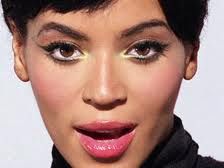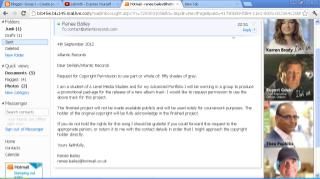Sunday 30 September 2012
Saturday 29 September 2012
Thursday 27 September 2012
Copyright Clearance - Ministry of Sound
I have written a letter to Ministry of Sound who own the rights to Wretch 32 featuring Josh Kumra ' Don't Go' to ask for permission if I would be able to use their song for my work.
Copyright Clearance - Warner Music Group
I have written a letter to Warner Music Group who own the rights to Ed Sheeran's ' The A Team' to ask for permission if I would be able to use their song for my work.
Copyright Clearance - XL Records
I have written a letter to XL Records who own the rights to Adele's ' Rolling In the Deep' to ask for permission if I would be able to use their song for my work.
The Music Industry
google.co.uk/images
Having a music video can be very helpful for the record label the artist is under as it will help not only to promote the artist , it will also promote the record label also if the music video is successful this could cause consumers to go and buy the single of the song as they enjoyed the video.
Having a music video can be very helpful for the record label the artist is under as it will help not only to promote the artist , it will also promote the record label also if the music video is successful this could cause consumers to go and buy the single of the song as they enjoyed the video.
Beyonce's Single Ladies is an example of the effect a music video can have on the record label , as it became such an iconic video , which sold over 6.9 million copies worldwide
In the record industry , as of 2012 there are 3 big record labels and they are
Sony BMG
Warner Music Group
Universal Music Group
Andrew Goodwin
Dr Andrew Goodwin says that there are 3 types of different music videos.
Disjuncture - When the video has no relevance or relationship to the song
Illustration - The lyrics follow the song this can be shown through movement such as dance
Amplification - It follows the lyrics but it gives a deeper meaning
Disjuncture - When the video has no relevance or relationship to the song
Illustration - The lyrics follow the song this can be shown through movement such as dance
Amplification - It follows the lyrics but it gives a deeper meaning
Ciara - Like a Boy shows illustration as she is dancing to show the attitudes of men
Rihanna - Man down shows examples of amplification as the lyrics relate to the song of her killing a man however deals with deeper meanings such as rape
Frank Ocean - Thinking About You , the video and song share no similarities . This a form of disjuncture
Tuesday 25 September 2012
Laura Mulvey
Laura Mulvey 1992
“In a world ordered by sexual imbalance, pleasure in looking
has been split between active/ male and passive female. The determining male
gaze projects its fantasy onto the female figure which is styled accordingly.”
The basis of this quote depicts the male artist in the music
industry to be the dominant figure in the music video. This then leaves the
females to submit to the conventions of being ‘eye candy’ to a male audience.
Examples include:
M.V.P – Rock Ya Body http://www.youtube.com/watch?v=smqn531E7dI
Full women wearing hardly any clothes, compared to the men
who are fully dressed.
The women are all in shape, taking attention away from the
men.
Kelly Rowland – Lay it on me how ever contradicts this as
instead of having the conventions of female dancers in the video Kelly Rowland
is the only female present and is surrounded by men dancing around her in an
explicit manor. http://www.youtube.com/watch?v=HhoewflkQu0
Carol Vernallis
Carol Vernallis: Experiencing music video: Aesthetics
and cultural context.
Carole Vernallis studied editing and camerawork closely in
music videos. She observed that edits in music video come much more frequently
than in film. She also noticed that many stand out as disjuncture and that
editing seems to have a rhythmic basis closely connected to the song.
- The
usual rules of ‘continuity’ editing (editing usually found in classic
broadcast fiction) are broken in order to draw attention to what is on the
screen.
- Edits
may be really obvious to draw attention to themselves such as wipes and
special effects added – Jump cuts are often used.
- A
master shot (basetrack) is frequently used to give the video structure.
- The
camera may move in time with the music.
Rihanna ft Calvin Harris – We found love http://www.youtube.com/watch?v=tg00YEETFzg
Base track shows her in one room singing and ends with her
sitting in the corner to express the effects of the relationship.
Lots of jump cuts,
Slow motion breaks continuity but matches rhythm of the song.
Andrew Goodwin
Andrew Goodwin -
‘Dancing in the Distraction Factory’
Andrew Goodwin feels that traditional narrative
analyses don’t really apply to Pop videos. He believes that Pop videos are
instead built around songs and often songs do not pose traditional narrative structures.
The Pop video uses the singer both as narrator
and as character.
The singer also often looks directly at the
camera – this is an extension performance and means they are trying to involve
the viewer at home with the performance.
Pop videos rely on repetition – often repeating
images similar to the way the song repeats choruses or lines.
It creates familiarity as certain rhythms from other songs
become apparent boosting expectations. It also acts as a marketing tool as
radio and television play makes it very familiar through repetition.
Pop songs and their videos do not have a form of closure or
ending. The 3 minute single that the video is based on must end and this is
often reflected in the structure of the music. It builds up to a climax or to a
constant repetition before then fading away.
Some videos are autonomous from the music they spring from.
The visualisation of a song may go beyond the original meaning. Sometimes the
video provides a visual pleasure that encourages repeated viewing, which
therefore promotes the music.
Sometimes the videos might be promoting over commodities
such as films.
Therefore it can be said that there are three types of
relations between songs and videos:
Illustration – This is where the video tells the
story of the lyric. (Pap don’t preach-Madonna)
R Kelly – Trapped in the closet http://www.youtube.com/watch?v=zFosUj6A22
Amplification – Occurs when the videos introduce
new meanings that don’t contradict with the lyrics but add layers of meaning.
Tyga ft. Chris Richardson – Far away http://www.youtube.com/watch?v=xBIfffmQR-4
Song about breaking up with a girl and
regretting it but video shows the breakup but becomes impossible to get back
together as she dies in a car crash.
Disjuncture – This is where there is little
connection between lyrics and video, or where the video contradicts the lyrics.
(Man in the Mirror – Michael Jackson)
Kanye West – Love lockdown - http://www.youtube.com/watch?v=HZwMX6T5Jhk
Monday 24 September 2012
RESEARCH: The Major Record Labels
These were the Big 4 major record labels however EMI is now in the process of being sold to Universal so in 2012, we have now come to the Big 3! These 3 labels dominate the music industry and have lots of subsidiary labels. There are also a collection of independant labels too.
Sunday 23 September 2012
Thursday 20 September 2012
Monday 17 September 2012
Saturday 15 September 2012
RESEARCH: Music Video Analysis
Carol Vernallis said:
"The narrative in music video is not always complete. It's not always balanced between narrative and performance, you don't always have narrative solution and they often pose questions that are unanswered"
Having read this, I analysed Mark Ronson's 'the bike song' to validate this approach
.
The narrative in this video is about a guy who is riding his bike and then someone steals it. The bikes come to life and come together to catch the thief and they do. They save the day and then he goes to the park with some girls and boys - and there bikes.
The main artist, who is Mark Ronson, is a participant in the song and isn't the central attention which goes against the conventions of a music video, however his position in the video still acts as some promotion and exposure for him and his look. The platinum blonde hair is a statement.
Business International act as the narrators and also participants. We see the artist sing predominatey during the chorus of the song and not a lot anywhere else. The rapper raps along to his part. The ratio of narrative to performance would be around 80:20 as we see much more narrative than performance.
"The narrative in music video is not always complete. It's not always balanced between narrative and performance, you don't always have narrative solution and they often pose questions that are unanswered"
Having read this, I analysed Mark Ronson's 'the bike song' to validate this approach
.
The narrative in this video is about a guy who is riding his bike and then someone steals it. The bikes come to life and come together to catch the thief and they do. They save the day and then he goes to the park with some girls and boys - and there bikes.
The main artist, who is Mark Ronson, is a participant in the song and isn't the central attention which goes against the conventions of a music video, however his position in the video still acts as some promotion and exposure for him and his look. The platinum blonde hair is a statement.
Business International act as the narrators and also participants. We see the artist sing predominatey during the chorus of the song and not a lot anywhere else. The rapper raps along to his part. The ratio of narrative to performance would be around 80:20 as we see much more narrative than performance.
Thursday 13 September 2012
RESEARCH: Function of a music video
The primary function of a music video is to promote the artist. This is done through lots of close ups and the artist being the central focus of the video.


Traditionally they will feature heavily in it, taking up approximately 70% of screen time.
The secondary function behind a music video is to promote the new single and persuade the consumer to purchase the album. It's almost like a taster of what to expect from the overall product.
Essentially, music videos are a form of promotion and exposure for an artist.


Traditionally they will feature heavily in it, taking up approximately 70% of screen time.
The secondary function behind a music video is to promote the new single and persuade the consumer to purchase the album. It's almost like a taster of what to expect from the overall product.
Essentially, music videos are a form of promotion and exposure for an artist.
Monday 10 September 2012
REFLECTING: AS Music Video Remake
Click This Link to my AS Music Video Remake
Three Technical Strengths:
Three Technical Weaknesses:
Three Technical Strengths:
- Their was a variety of shots that were used throughout and close ups which illustrate the purpose of a music video which is to promote the artist.
- It is a good re-creation of the original video and utilised the aspects that the original video holds.
- The framing of the characters in the video was good and appropriate for what was going on.
Three Technical Weaknesses:
- Continuity was a big technical weakness with the music video remake because in one shot the girl is taking off the jacket and in the next she is wearing it again. For my music video, I'll ensure continuity is something I consider whilst filming.
- Our use of base tracks was limited so it didn't completely follow the conventions of a music video and it shows in the editing.
- There was a moment where the cut didn't appear seamless and jumps.
Subscribe to:
Posts (Atom)



























